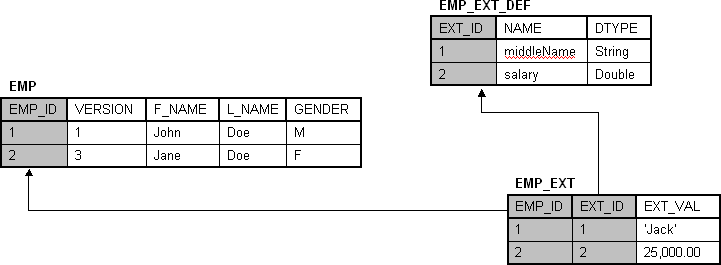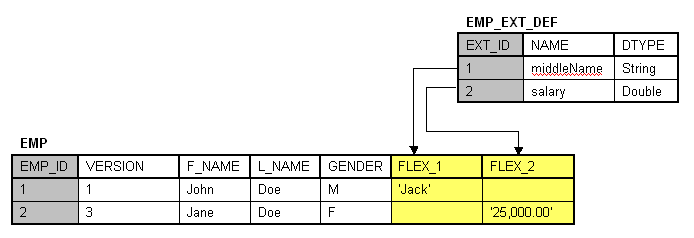Notice: this Wiki will be going read only early in 2024 and edits will no longer be possible. Please see: https://gitlab.eclipse.org/eclipsefdn/helpdesk/-/wikis/Wiki-shutdown-plan for the plan.
Difference between revisions of "EclipseLink/Examples/JPA/Extensible"
(→Values Extensions) |
(→Flex Extensions) |
||
| Line 47: | Line 47: | ||
@Transient | @Transient | ||
| − | @FlexExtensions(initial= | + | @FlexExtensions(initial=2, create=false) |
private Map<String, Object> extensions = new HashMap<String, Object>(); | private Map<String, Object> extensions = new HashMap<String, Object>(); | ||
</source> | </source> | ||
| + | |||
| + | The underlying schema for the extension storage would look like: | ||
| + | |||
| + | [[Image:El-flex-extensions-schema.gif]] | ||
==== Configuration ==== | ==== Configuration ==== | ||
Revision as of 11:34, 2 March 2011
Extensible Entities Example
This example illustrates how EclipseLink 2.2 can be used to build a domain model that allows addition 'extension' properties, relationships, and types to added and used in the application.
NOTE: This functionality is being formalized into new features for EclipseLink Indigo (2.3) in its Extensibility features.
Getting the Code
The example is being developed within the trunk of EclipseLink:
- SVN: [1]
Usage Instructions
Code Examples
The following are code snippets extracted from the example to illustrate key use-cases.
Values Extensions
Values extensions use a separate table to store the extension properties. In this example the Employee entity type uses values extensions and is configured as:
@Transient @ValuesExtensions(table = @Table(name = "emp_ext"), id = @Column(name = "EXT_ID"), value = @Column(name = "EXT_VALUE")) private Map<String, Object> extensions;
It is annotated as @Transient so that the default JPA mappings are not applied. The configuration section below shows how the mapping is actually enabled.
Flex Extensions
In this example the Address class uses flex extensions and is configured as:
@Transient @FlexExtensions(initial=2, create=false) private Map<String, Object> extensions = new HashMap<String, Object>();
The underlying schema for the extension storage would look like:
Configuration
In order to enable the extensions a session customizer is used. This will use the ExtensionManagerHelper to enable extensions usage in the specified classes.
src/model.extensions.ExtensionsCustomizer
public class ExtensionsCustomizer implements SessionCustomizer { public void customize(Session session) throws Exception { ExtensionManagerHelper helper = new ExtensionManagerHelper(session); helper.initializeValueExtensions(Employee.class, "extensions"); helper.initializeFlexExtensions(Address.class, "extensions"); } }


